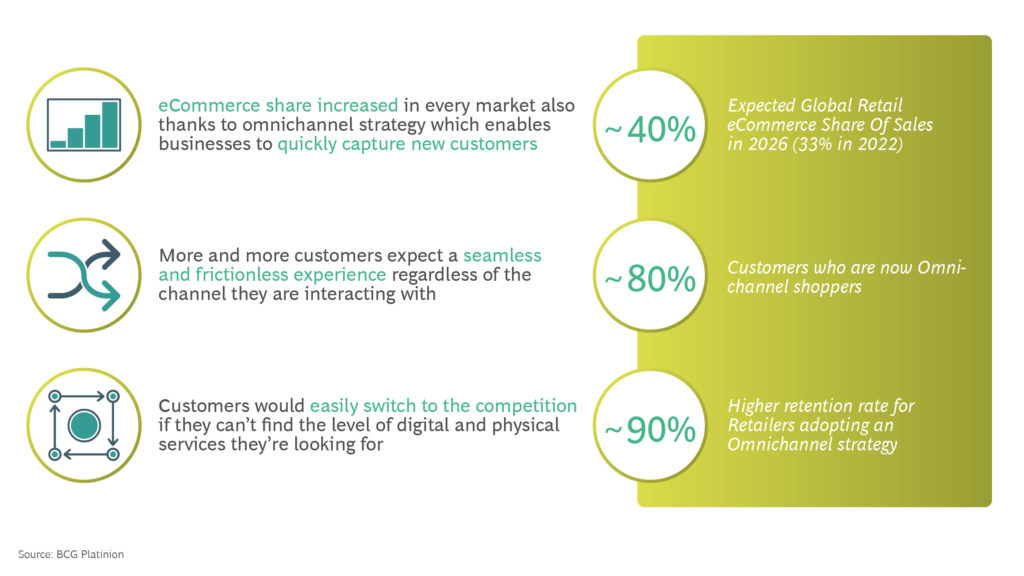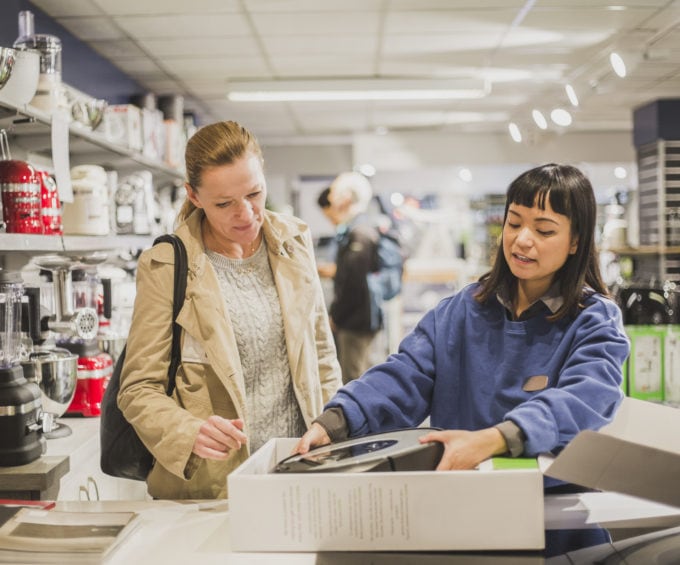Convenience is the secret of e-commerce’s success: shopping anytime and anywhere, on the sofa in the evening, on the train to work. Customers now also expect goods to arrive not only quickly and reliably, but exactly when and where they want them. The COVID-19 pandemic has significantly strengthened this trend: the number of high-speed delivery apps has risen rapidly since 2020. The success of delivery providers shows that retail companies are only viable in the future with flexible and robust fulfillment strategies and processes.
Omnichannel unlocks relevant opportunities but introduces new challenges for retailers

A recent study showed that 30 percent of retail customers expect “turbo delivery”. Delivery is therefore part of the customer experience; shopping does not end with conversion, but with the handover of the goods. Smooth and fast delivery on the desired date or the same day is now considered standard–many services even offer deliveries in less than 30 minutes. These services have become a must-have for customers, and some retailers are establishing partnerships to support and scale rapid delivery.
“Customers expect goods to arrive exactly when and where they want them.”
"Otherwise, players will register a significant loss in market share over the next year with an increasing risk of outplacement.
During the last decade Retailers strongly invested on “front-end” processes innovation for example eCommerce solutions, Digital Marketing and Customer Experience Design.
In recent years the focus shifted towards “back-end” components where Omnichannel Order Management is one of the core buildings blocks and nowadays one of the “hot-topic”.
In such an unprecedent-changes context, the Omnichannel Order Management assumes a key strategic role for a Retailer Business, with other supply chain systems, such as Warehouse Management System (WMS) and Transportation Management System (TMS), represent the key enablers of the Omnichannel Customer Experience.
They support the “customer-facing” processes with information, workflows and process optimization and orchestration. To win the future in Retail, Players have to consider both the customer-centric and the cost-optimization directions, focusing their effort on strategic initiatives to generate business impacts as the Omnichannel Order Management evolution can deliver.
Omnichannel Order Management is one of the key components of the omnichannel framework and forms the interface between the company’s “back-end” and “front-end” assets.

The Omnichannel Order Management as the basis for the omnichannel experience
The Omnichannel Order Management is a key element of the new customer-centric approach for the omnichannel evolution. It allows optimizing, orchestrating, automating, and streamlining the order fulfillment decisions and processes on the basis of business strategic objectives such as margins, customer experience, and others.
It improves efficiency and enables the harmonization of digital and physical touchpoints into a single, concentric view that provides customers with a seamless omnichannel experience along the entire journey.
Additional Omnichannel Order Management capabilities
There are many Omnichannel Order Management solutions that have been developed both by Enterprise Solution Providers and new market challengers. Despite the fact that all of them cover the core Order Management capabilities, some have also developed extensions and additional modules that allow retailers to manage Order Management adjacent processes within a single solution.
Examples of these include:
- Inventory Visibility: A single dashboard provides an overview of all the retailer’s inventories, including distribution centers, dark stores and much more. It provides visibility for goods already in transport within the logistics network – including external third-party suppliers. It also displays information that supports optimal inventory planning and the calculation of indicators such as “Availability to Promise” and “Availability to Sell”.
- Store Fulfillment: The entire order-processing sequence in the stores becomes visible. A special user interface can guide employees through the processing activities such as Pick & Pack. The various tasks are listed and can be prioritized according to delivery time, for example.
- Customer Service: This includes managing after-sales processes with specific workflows, for example, returns regardless of the original purchase channel. Customer care is supported with order tracking information via dedicated dashboards.
Omnichannel Order Management impacts relevant Retailer dimensions
A recent experience by BCG Platinion demonstrated how the implementation of a Omnichannel Order Management is more than an IT project. It involves multiple business units and affects the operating model, processes, customer experience and satisfaction, and business results.

Operating model
The Omnichannel Order Management rollout requires a redesign and expansion of the operating model at enterprise level.
New job roles need to be defined, areas of responsibility expanded, and the online and offline product assortment may need to be adjusted.
The introduction of Ship from Store will bring changes to the way sales staff and in-store processes work as new activities such as Pick & Pack are added.
Processes
The Omnichannel Order Management guarantees the integration of different shopping channels and manages order intake from multiple touchpoints such as online stores or physical stores with multiple delivery options that can be activated depending on the retailer’s delivery infrastructure.
The system identifies the optimal fulfillment location, taking into account relevant business variables such as transport costs, distance or expected delivery date, leading to saving up to 40 percent of fulfillment costs in highly-distributed retailer networks.
Customer experience and satisfaction
Improved delivery service can increase Net Promoter Scores by an average of 20 percent for retailers.
Business results
Introducing new use cases such as express pickup or next-day delivery.
Improving the customer experience, and the ability to use any node in the logistics network as a delivery center leads to higher order volumes and opens up cross-selling potential—and increased revenue.
Potentially, every single inventory distributed across the network can be sold to a customer online.


Selling goods quickly increases margins and makes marketing promotions such as discounts on landed goods obsolete.
The Omnichannel Order Management improves the efficiency of processes involved in E2E.
It optimizes delivery—especially in the last mile—and reduces manual activities thanks to a set of predefined user interfaces and automated workflows that limit human error.
It also has the potential to reduce inventory management costs.
Retailers must choose the right Omnichannel Order Management solution that meets their specific needs. This decision will depend on the market context and competitive landscape, the required functionality, order volumes and performance, and the intended IT architecture. However, although choosing the solution is an important step, it is the implementation process and the choice of implementation partner that have proven to be most critical to the project’s success.
Based on its hands-on experience, BCG Platinion has identified seven key lessons learned from Omnichannel Order Management implementation
Omnichannel Order Management is a strategic element for retailers’ business model transformation, competitive differentiation, and operational excellence. The good news is that omnichannel order management programs can also be funded thanks to solid business case opportunities generating fast returns on investments.
Discover more about the world of Consumer here:
The Route to Customer-Centric Commerce
What’s the priority to work on to set sail toward a new customer-centric e‑commerce? Read here how IT Architectures have to evolve after COVID-19.
Personalisation excellence accelerates profits
COVID-19 has radically changed consumer behavior. Sales through Online channels have doubled since the first days of the COVID-19 pandemic. Find out more in this article.
About the Authors
Antonino Campione
Associate DirectorMilan, Italy
Antonino Campione is a Associate Director in the Milan office of BCG Platinion. He is specialized in several Technology & Digital core topics and is member of the Leadership Group of BCG Platinion Consumer and Retail Practice Area (CPA).
Francesca Boarolo
Senior IT ConsultantMilan, Italy
Francesca is a Senior Consultant in the Milan office of BCG Platinion. Francesca has experience in global digital transformation programs – her roles included project management, agile implementation and business analysis, SW and SI selections within the omnichannel domain.
Filippo Magnani is an Senior IT Consultant at BCG Platinion in Milan, specialized in digital transformation and IT strategy global programs. His work spans insurance, industrial goods, and consumer electronics, with particular focus on strategic partner selection, operating model design, and business case development. Previously, he was a Technology Consultant at Accenture, focusing on digital platform projects. Filippo holds a BSc and MSc in Management Engineering from Politecnico of Milan.
Simone Gabbana
Former IT ConsultantMilan, Italy
Simone Gabbana is a Consultant at BCG Platinion with 4 years of experience in digital transformation projects. He supported clients in process redesign and digital roadmap definition within both the Financial Services and Retail Industry. In addition, he also participated in Vendor and System Integrator selection supporting functional analysis.









